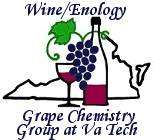 Enology Notes #57, August 16, 2002
Enology Notes #57, August 16, 2002
To: Regional Wine Producers
From: Bruce Zoecklein
Subject: The 2002 season-pH and TA, Sur Lie Storage, HACCP-Like Outline, and Survey
Practical Considerations and Recommendations for Fermentation.
The 2002 Season-pH and TA. With the heat and drought, the 2002 season appears to be a challenge. The fruit is maturing at a very rapid rate with the potential for very low titratable acidity and elevated pHs. Grape pH and acidity are linked to environmental conditions (ambient temperatures, canopy temperatures, soil moisture, soil oxygen, etc.) and potassium concentrations.
A plant enzyme system (hydrogen potassium ATPase) regulates the uptake of soil potassium (K+) into the plant. Potassium ions are exchanged one-for-one with hydrogen ions (H+). The greater the potassium concentration, the fewer the hydrogen ions and the higher the fruit pH.
So far this season, the conditions would appear favorable for high pH values in the fruit. The viticultural approaches to help manage pH include canopy management, vine balance management and avoiding stress.
Moisture stress significantly increases fruit pH. Severe stress late season increases K+ uptake which aids pH evolution.
Excessively light crop on high capacity vines/sites results in excess vigor and pH.
Over-cropping vines can delay maturity. This delay can result in significant reductions in acidity and increases in pH.
Berry size increases with maturity. It varies significantly with thermal expansion or water stress - related shrinkage during daylight, and water influx and expansion at night. Small changes in berry weight or diameter lead to large differences in fruit composition, as discussed in previous issues of Enology Notes. For this reason, berry size estimation as determined by berry weight should be part of every winery's maturity evaluation gauge.
For example, an increase in berry weight could result in an increased berry diameter of 5%, resulting in a 14% increase in berry volume, resulting in a 14% decrease in acidity, simply as a result of dilution.
As discussed in Enology Notes #6 (posted on the web at www.vt.wines.info), storing wines sur lie can have a large influence on wine structural components.
During sur lie storage, yeast components such as cell wall polysaccharides, and particularly mannoproteins, are released into the wine. These macromolecules can positively influence structural integration, phenols (including tannins), body, aroma, oxygen buffering and wine stability. The interest in lees utilization goes beyond barrel-fermented Chardonnay.
Yeast derived macromolecules provide a sense of sweetness as a result of binding with wood phenols and organic acids, aiding in the harmony of a wine's structural elements. The natural fining that occurs contributes to reducing the yellow tones in whites, and helps to protect against oxidation of certain fruit aroma compounds.
As discussed at our Norton Roundtable and the Pre-harvest Workshop, it is important to differentiate between light lees and heavy lees.
Heavy lees can be defined as the lees which precipitate within 24 hours immediately post-fermentation. They are composed of large particles (greater than 100 microns) and consist of vegetal particles, agglomerates of tartrate crystals, yeasts, bacteria, and protein-polysaccharide-tannin complexes.
Light lees, on the other hand, can be defined as those that precipitate from the wine more than 24 hours post-fermentation. These are composed mainly of small particles (1-25 microns) of yeasts, bacteria, tartaric acid, protein-tannin complexes and some polysaccharides (Delteil, 2002).
There is no value in storing wine on heavy lees. Indeed, such storage can result in off aroma and flavors, and a depletion of sulfur dioxide.
Light lees storage, however, can have a significant advantage in structural balance, complexity and stability.
At both the Norton Winemakers Roundtable and the Pre-Harvest Workshop, I shared some data from Delteil (2002) who compared two red wines. One red wine was barrel stored on light lees for 9 months; the other, racked several times prior to barreling, was stored for the same period without lees. These two Syrah wines differed significantly in their palate and aroma profiles.
The wine stored sur lie had a much lower perception of astringency and a greater integration of the phenolic elements. The sur lie wine also had a lower perception of oak character, resulting in a higher perception of varietal fruit.
I will shortly post on the Enology-Grape Chemistry Group's web site the outline of the HACCP plan that I discussed at the Pre-Harvest Workshop. This will be available at www.vtwines.info. Go to extension, on-line publications.
Survey of all Virginia Vineyards.
Researchers at Virginia Commonwealth University (VCU), working in conjunction with the Virginia Winegrowers Advisory Board, are conducting a survey of all vineyards and wineries in the state. The results of this survey will be used by VCU to estimate the economic importance of Virginia's wine industry and to develop an industry profile.
It is very important that each of the state's vineyards be included in this study. A survey was mailed to the owners (or a key contact) at each vineyard on July 17. If you still have not received a survey, or if you are unsure, please contact Mr. Billy Kinsey at VCU. You may reach him at (804) 278-0961 or by e-mail at bwkinsey@vcu.edu. Thank you for your help!
Subscription to Enology Notes. All past Enology Notes and Vintner's Corner newsjournals are posted on the Enology-Grape Chemistry Group's web site at: http://www.fst.vt.edu/zoecklein/index.html or http://www.vtwines.info/. Enology Notes are slightly different in content from the subscription based Vintner's Corner newsjournal.
To be added to the Enology Notes list serve send an email message to bzoeckle@vt.edu with the word "ADD" or "REMOVE" in the subject line.
Dr. Bruce Zoecklein
Associate Professor and Enology Specialist
Head Enology-Grape Chemistry Group
Department of Food Science and Technology
Virginia Tech
Blacksburg VA 24061
Enology-Grape Chemistry Group Web address: www.vtwines.info or www.fst.vt.edu/zoecklein/index.html
Phone: (540) 231-5325
Fax: (540) 231-9293
Email: bzoeckle@vt.edu